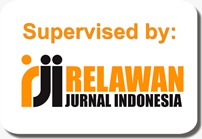ANALYSIS OF UNCERTAINTY DURING THE COVID-19 PANDEMIC ON NIM, ROA, NPL, AND BOPO AT RURAL BANKS
Abstract
Keywords: Uncertainty, Standard Deviation of Assets, Standard Deviation of Funding, Standard Deviation of Loan Growth, NIM, ROA, NPL, BOPO, BPR
Full Text:
PDFReferences
Ahir, H., Bloom, N., & Furceri, D. (2018). The world uncertainty index. SSRN ElectronicJournal,https://doi.org/10.2139/ssrn.3275033
Alessandri, P., & Bottero, M. (2020). Bank lending in uncertain times. European Economic Review, 128.https://doi.org/10.1016/j.euroecorev.2020.103503
Athari, S.A. (2021). Domestic political risk, global economic policy uncertainty, and banks' profitability: evidence from Ukrainian banks. Post-Communist Economies, 33(4), 458–483.https://doi.org/10.1080/14631377.2020.1745563
Berger, A.N., Guedhami, O., Kim, H.H., & Li, X. (2020). Economic policyuncertainty and bank liquidity hoarding. Journal of Financial Intermediation.
Bloom, N., Floetotto, M., Jaimovich, N., Saporta-Eksten, I., & Terry, S. J. (2018). Really uncertain business cycles. Econometrica, 86(3), 1031–1065.
Borio, C., Gambacorta, L., & Hofmann, B. (2017). The influence of monetary policy on bank profitability. International Finance, 20(1), 48–63.
Brigham, EF, Houston. (2010). Fundamentals of Financial Management. Translated by Ali Akbar Yulianto, Book 1, 11th Edition, Salemba Empat Publisher
Buch, C. M., Buchholz, M., & Tonzer, L. (2015). Uncertainty, bank lending, and bank-level heterogeneity. IMF Economic Review, 63(4), 919–954. https://doi. org/10.1057/imfer.2015.35
Chen, M., Wu, J., Jeon, B.N., & Wang, R. (2017). Monetary policy and bank risk-taking: Evidence from emerging economies. Emerging Markets Review, 31.
Chi, Q., & Li, W. (2017). Economic policy uncertainty, credit risks and banks' lending decisions: Evidencefrom Chinese commercial banks. China Journal of Accounting Research, 10(1), 33–50.https://doi.org/10.1016/j.cjar.2016. 12,001
Dahir, A.M., Mahat, F., Razak, N.H.A., & Bany-Ariffin, A.N. (2019). Capital, funding liquidity, and bank lending in emerging economies: An application of the LSDVC approach. Borsa Istanbul Review, 19(2), 139–148.
Danisman, G.O., Demir, E., & Ozili, P. (2021). Loan loss provisioning of US banks: Economic policy uncertainty and discretionary behavior. International Review of Economics and Finance, 71, 923–935.
Dang, V. D., & Huynh, J. (2021). Bank funding, market power, and the bank liquidity creation channel of monetary policy. Research in International Business and Finance, 59.https://doi.org/10.1016/J.RIBAF.2021.101531
Hartzmark, S. M. (2016). Economic uncertainty and interest rates. Review of Asset Pricing Studies, 6(2), 179–220.https://doi.org/10.1093/rapstu/raw004
Hery. (2015). Financial Report Analysis. Yogyakarta: CAPS
Kiviet, J.F. (1995). On bias, inconsistency, and efficiency of various estimators in dynamic panel data models. Journal of Econometrics, 68(1), 53–78.
Kozeniauskas, N., Orlik, A., & Veldkamp, L. (2018). What are uncertainty shocks? Journal of Monetary Economics, 100, 1–15.
McDonald, R., & Siegel, D. (1986). The value of waiting to invest. Quarterly Journal of Economics, 101(4), 707–727.https://doi.org/10.2307/1884175
Nguyen, C.P., Le, T.H., & Su, T.D. (2020). Economic policy uncertainty and credit growth: Evidence from a global sample. Research in International Business and Finance, 51.https://doi.org/10.1016/j.ribaf.2019.101118
Pindyck, R. S. (1988). Irreversible investment, capacity choice, and the value of the firm. The American Economic Review, 78(5), 969–985.
POJK No.11/POJK.03/2020 concerning National Economic Stimulus as a Countercyclical Policy for the Impact of the Spread of Corona Virus Disease 2019.
POJK No.18/POJK.03/2020 concerning Written Orders for Handling Bank Problems.
POJK No.48/POJK.03/2020 concerning Amendments to Financial Services Authority Regulation Number 11/POJK.03/2020 concerning National Economic Stimulus as a Countercyclical Policy for the Impact of the Spread of Coronavirus Disease 2019.
Decree of the Director of Bank Indonesia Number 30/12/KEP/DIR concerning Procedures for Assessing the Health Level of BPR.
Sekaran, Uma & Bougie, Roger (2020). Research methods for business: a skill-building approach. Wiley seventh edition. Chichester, West Sussex, United Kingdom.
Valencia, F. (2017). Aggregate uncertainty and the supply of credit. Journal of Banking and Finance, 81, 150–165.
DOI: https://doi.org/10.31846/jae.v13i2.857
Refbacks
- There are currently no refbacks.

This work is licensed under a Creative Commons Attribution-NonCommercial-NoDerivatives 4.0 International License.
e-Jurnal Apresiasi Ekonnomi Indexed by:












